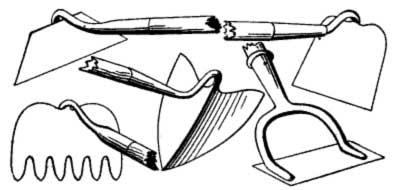CULINARY HERBS
STATUS AND USES
Some readers of a statistical nature may be disappointed to learn that figures on the value of the annual crops of individual herbs, the acreage devoted to each, average cost, yield and profit an acre, etc., are not readily available, and that the only way of determining the approximate standing of the various species is the apparent demand for each in the large markets and stores... although you might get information of value for you from local outlets, such as farmer's markets..
Unquestionably the greatest call is for parsley, which is used in restaurants and hotels more extensively as a garnish than any other herb. In this capacity it ranks about equal with watercress and lettuce, which both find their chief uses as salads. As a flavoring agent it is probably less used than sage, but more than any of the other herbs. It is chiefly employed in dressings with mild meats such as chicken, turkey, venison, veal, with baked fish; and for soups, stews, and sauces, especially those[Pg 20] used with boiled meats, fish and fricassees of the meats mentioned. Thus it has a wider application than any other of the culinary herbs.
Sage, which is a strongly flavored plant, is used chiefly with such fat meats as pork, goose, duck, and various kinds of game. Large quantities are mixed with sausage meat and, in some countries, with certain kinds of cheese. Throughout the United States it is probably the most frequently called into requisition of all herbs, probably outranking any two of the others, with the exception of parsley.
Garden Hoes of Various StylesThyme and savory stand about equal, and are chiefly used like parsley, though both, especially the former, are used in certain kinds of sausage. Marjoram, which is similarly employed, comes next, then follow balm, fennel, and basil. These milder herbs are often mixed for much the same reason that certain simple perfumes are blended—to produce a new odor—combinations of herbs resulting in a new compound flavor. Such compounds are utilized in the same way that the elementary herbs are.[Pg 21]
In classes by themselves are tarragon and spearmint, the former of which is chiefly used as a decoction in the flavoring of fish sauces, and the latter as the universal dressing with spring lamb. Mint has also a more convivial use, but this seems more the province of the W. C. T. U. [Women's Christian Temperance Union] than of this book to discuss.
Dill is probably the most important of the herbs whose seeds, rather than their leaves, are used in flavoring food other than confectionery. It plays its chief role in the pickle barrel. Immense quantities of cucumber pickles flavored principally with dill are used in the restaurants of the larger cities and also by families, the foreign-born citizens and their descendants being the chief consumers. The demand for these pickles is met by the leading pickle manufacturers who prepare special brands, generally according to German recipes, and sell them to the delicatessen and the grocery stores. If they were to rely upon me for business, they would soon go bankrupt. To my palate the dill pickle appeals as almost the acme of disagreeableness.
